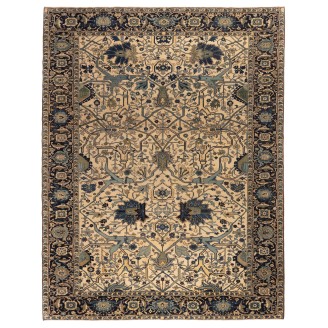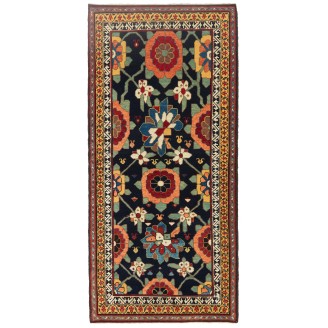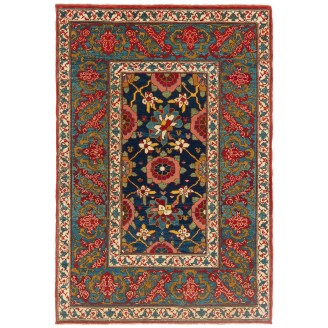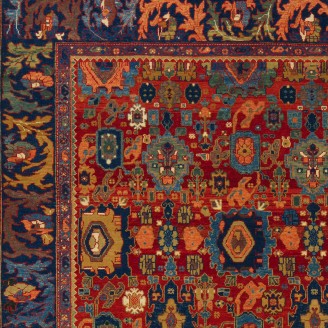COLLECTION OF BIDJAR RUGS
Roof of Iran. Showcases the exquisite artistry and durability of Persian weaving
Model: ART00511
Dimensions: 6'7" X 10'2"(202cm x 310cm)
This offset pattern is composed of palmettes and flowers, one has the impression that it is only part of a larger scheme designed 19th-century rug from Bidjar region, Eastern Kurdistan area. Very similar palmettes, drawn in a curvilinear manner and combined with identical forked leaves, can be seen ..
Price:
$12,000
Ex Tax:$12,000
Model: ART00587
Dimensions: 7'1" X 5'0"(216cm x 153cm)
The source of the rug comes from the book Antique Rugs of Kurdistan A Historical Legacy of Woven Art, James D. Burns, 2002 nr.45. This is a popular design employed by the Kurds, called bid majnum (or Bid Majnun, weeping willow) 17th-century rug from Sa'uj Bulagh, Eastern Kurdistan are..
Price:
$6,600
Ex Tax:$6,600
Model: ARTK0008
Dimensions: 8'10" X 11'5"(271cm x 350cm)
The source of the rug comes from the book Islamic Carpets, Joseph V. McMullan, Near Eastern Art Research Center Inc., New York 1965 nr.22. This is a system of arabesque-designed 19th-century rugs from Gerous ( Garrus or Garus ) region, Eastern Kurdistan area. This rug is a splendid echo of the Arabe..
Price:
$33,000
Ex Tax:$33,000
Model: ART00491
Dimensions: 5'4" X 3'4"(163cm x 104cm)
The source of the rug comes from the book Islamic Carpets, Joseph V. McMullan, Near Eastern Art Research Center Inc., New York 1965 nr.22. This is a system of arabesque-designed 19th-century rugs from Gerous ( Garrus or Garus ) region, Eastern Kurdistan area. This rug is a splendid echo of the ..
Price:
$3,550
Ex Tax:$3,550
Model: ART00605
Dimensions: 3'3" X 8'4"(101cm x 256cm)
The source of the rug comes from the book Islamic Carpets, Joseph V. McMullan, Near Eastern Art Research Center Inc., New York 1965 nr.22. This is a system of arabesque-designed 19th-century rugs from Gerous ( Garrus or Garus ) region, Eastern Kurdistan area. This rug is a splendid echo of the ..
Price:
$5,620
Ex Tax:$5,620
Model: ART00589
Dimensions: 6'1" X 8'2"(186cm x 250cm)
The source of the rug comes from the book Islamic Carpets, Joseph V. McMullan, Near Eastern Art Research Center Inc., New York 1965 nr.22. This is a system of arabesque-designed 19th-century rugs from Gerous ( Garrus or Garus ) region, Eastern Kurdistan area. This rug is a splendid echo of the ..
Price:
$10,100
Ex Tax:$10,100
Model: ART00479
Dimensions: 4'8" X 7'1"(143cm x 217cm)
The source of the rug comes from the book Orient Star - A Carpet Collection, E. Heinrich Kirchheim, Hali Publications Ltd, 1993 nr.79. This is an unusual design of 18th or 19th-century rug from Khila, Kuba region East Caucasus area. Very similar palmettes, drawn in a curvilinear manner and combined ..
Price:
$6,200
Ex Tax:$6,200
Model: ART00616
Dimensions: 2'8" X 5'8"(83cm x 174cm)
The source of the rug comes from the book Antique Rugs of Kurdistan A Historical Legacy of Woven Art, James D. Burns, 2002 nr.4. This was an exclusive example of a Mina Khani lattice design mid-19th century rug from Koliya'i, Southern Kurdistan area. The mina khani is composed of a se..
Price:
$3,130
Ex Tax:$3,130
Model: ART00674
Dimensions: 2'9" X 5'8"(84cm x 173cm)
Introducing the exquisite Kurdish Bidjar Mina Khani Rug (Model: ART00674) from Ararat Rugs, a masterpiece that exemplifies the rich weaving traditions of the Bidjar region in Northwest Persia. This handwoven rug features the intricate Minahani design, celebrated for its harmonious blend of..
Price:
$2,800
Ex Tax:$2,800
Model: ART00216
Dimensions: 6'5" X 10'0"(198cm x 306cm)
The source of the rug comes from the book Antique Rugs of Kurdistan A Historical Legacy of Woven Art, James D. Burns, 2002 nr.2. This was an exclusive example of a Mina Khani lattice design mid-19th century rug from Koliya'i, Southern Kurdistan area. The mina khani is composed of a series of rows of..
Price:
$18,000
Ex Tax:$18,000
Model: ART00487
Dimensions: 4'9" X 6'11"(147cm x 211cm)
The source of the rug comes from the book Antique Rugs of Kurdistan A Historical Legacy of Woven Art, James D. Burns, 2002 nr.2. This was an exclusive example of a Mina Khani lattice design mid-19th century rug from Koliya'i, Southern Kurdistan area. The mina khani is composed of a series of rows of..
Price:
$5,900
Ex Tax:$5,900
Model: ART00494
Dimensions: 2'9" X 6'3"(84cm x 192cm)
The source of the rug comes from the book Antique Rugs of Kurdistan A Historical Legacy of Woven Art, James D. Burns, 2002 nr.4. This was an exclusive example of a Mina Khani lattice design mid-19th century rug from Koliya'i, Southern Kurdistan area. The mina khani is composed of a series of rows of..
Price:
$2,760
Ex Tax:$2,760
Model: ART00493
Dimensions: 3'4" X 4'11"(104cm x 152cm)
The design source of the rug comes from the book Antique Rugs of Kurdistan A Historical Legacy of Woven Art, James D. Burns, 2002 nr.4. This was an exclusive example of a Mina Khani lattice design mid-19th century rug from Koliya'i, Southern Kurdistan area. The mina khani is composed ..
Price:
$3,430
Ex Tax:$3,430
Model: ART00514
Dimensions: 3'4" X 5'2"(104cm x 160cm)
The source of the rug comes from the book Antique Rugs of Kurdistan A Historical Legacy of Woven Art, James D. Burns, 2002 nr.4. This was an exclusive example of a Mina Khani lattice design mid-19th century rug from Koliya'i, Southern Kurdistan area. The mina khani is composed of a se..
Price:
$2,880
Ex Tax:$2,880
Model: ART00715
Dimensions: 6'0" X 7'10"(184cm x 240cm)
Introducing the exquisite Palmettes and Flower Lattice Rug (Model: ART00715) from Ararat Rugs, a masterful representation of traditional Persian craftsmanship. This handwoven rug showcases the intricate "Palmettes and Flowers Lattice" design, a pattern deeply rooted in the rich history of ..
Price:
$8,000
Ex Tax:$8,000
Model: ART00608
Dimensions: 4'10" X 7'8"(149cm x 234cm)
This offset pattern is composed of palmettes and flowers, one has the impression that it is only part of a larger scheme designed for 19th-century rugs from the Bidjar region, Eastern Kurdistan area. Very similar palmettes, drawn in a curvilinear manner and combined with identical forked leaves, can..
Price:
$7,300
Ex Tax:$7,300
Model: ART00542
Dimensions: 4'8" X 7'3"(144cm x 221cm)
This offset pattern is composed of palmettes and flowers, one has the impression that it is only part of a larger scheme designed 19th-century rug from the Bidjar region, Eastern Kurdistan area. Very similar palmettes, drawn in a curvilinear manner and combined with identical forked leaves, can be s..
Price:
$6,000
Ex Tax:$6,000
Model: ART00603
Dimensions: 5'7" X 2'11"(171cm x 91cm)
This offset pattern is composed of palmettes and flowers, one has the impression that it is only part of a larger scheme designed for 19th-century rugs from the Bidjar region, Eastern Kurdistan area. Very similar palmettes, drawn in a curvilinear manner and combined with identical forked leaves, can..
Price:
$3,150
Ex Tax:$3,150
Model: ART00547
Dimensions: 6'6" X 9'6"(200cm x 290cm)
This offset pattern is composed of palmettes and flowers, one has the impression that it is only part of a larger scheme designed for 19th-century rugs from the Bidjar region, Eastern Kurdistan area. Very similar palmettes, drawn in a curvilinear manner and combined with identical forked leaves, can..
Price:
$18,000
Ex Tax:$18,000
Model: ART00513
Dimensions: 3'4" X 5'3"(104cm x 162cm)
This offset pattern is composed of palmettes and flowers, one has the impression that it is only part of a larger scheme designed for 19th-century rugs from the Bidjar region, Eastern Kurdistan area. Very similar palmettes, drawn in a curvilinear manner and combined with identical forked leaves, can..
Price:
$2,920
Ex Tax:$2,920
Model: ART00716
Dimensions: 10'2" X 5'10"(310cm x 179cm)
This offset pattern is composed of palmettes and flowers, one has the impression that it is only part of a larger scheme designed 19th-century rugs from the Bidjar region, Eastern Kurdistan area. Very similar palmettes, drawn in a curvilinear manner and combined with identical forked leaves, can be ..
Price:
$11,650
Ex Tax:$11,650









































